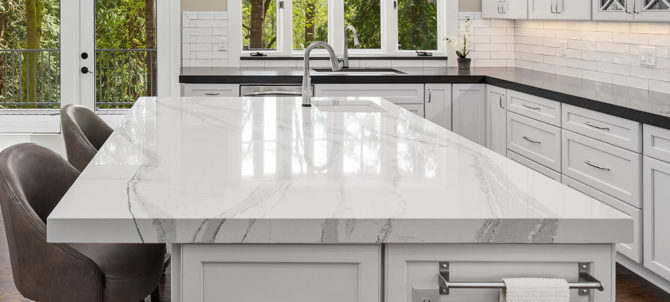
When you install countertops in your home, you know what you are working with, but when you move to a new house, you don’t know the countertops installed there. If this is your current situation, you must be asking, what countertops do I have, right?
Well, there are several ways you can tell the kind of kitchen countertops you currently have. Some of these ways include:
Check the uniformity of the countertops
You can tell the nature of your countertops by inspecting their uniformity. If your units have a uniform color and consistency throughout, you are probably looking at quartz countertops.
Since quartz slabs are manufactured, they tend to be uniform, with little variations in patterns and textures.
To make quartz slabs, manufacturers mix ground stones with resins and polymers. Some quartz countertops blend ground marble, granite, and other natural stones.
The beauty of quartz countertops is they are tough and take a lot of abuse. They also require little maintenance, so you don’t need to worry about them getting easily stained.
Look out for grainy and blurry color patches.
If your countertops have grainer and blurry color patches instead of distinct patches, you are most likely looking at granite countertops.
Granite stone is naturally available and has been around for thousands of years, and over the years, it has been heavily used in the construction of monuments, bridges, and buildings.
Granite countertops come in different colors as a result of an assortment of different minerals available in the stone. These minerals include: mica, feldspar, quartz, and many others.
Besides identifying granite by its grainier and blurry look, you can also identify it by the many crystals and clumps of minerals that it contains. When you look at the granite slab, you see veracious pieces in speckled patterns that come together to form a stone.
Look at translucency
Can you see a few millimeters past the surface? You have marble countertops in your kitchen. Marble is one of the most elegant natural stones in the world, and for centuries, it has been used to construct palaces fit for kings and statues dedicated to various gods.
Marble free of impurities is solid white, but this is not always the case. In most cases, it contains impurities that make it pink, bluish, gray, yellow, or black.
The colors appear as swirls or veins throughout the stone, with no repeating or symmetrical patterns and varying dimensions and depths.
True marble has unparalleled glossiness that lasts for a long time.
Most people are confused about whether they are looking at marble or granite countertops. If you aren’t sure about what you have on your surfaces, undertake the cut test.
Here you cut the countertop with a sharp object such as a knife. Real marble will show scratches and etching over time. The countertop is most likely granite or manufactured stone if you scratch the surface but don’t see any damage.
Which is the best countertop to have?
Well, there is no right or wrong countertop—it depends on your preferences. If you like the current look of your countertops, you need to take good care of them to retain the elegant look.
Regardless of the countertops on your surfaces, one of the things you shouldn’t do is expose them to heat. As much as the countertops are tough and can withstand high temperatures, you should note that they aren’t heatproof.
You might get away with placing the hot pots and pans on the surfaces a few times, but when you repeatedly do it, you stand to ruin your surfaces.
To protect your quartz, marble, or granite kitchen countertops Durham, have trivets and other heat-insulating materials that will prevent the heat from getting to the countertops.
For your marble and granite counters, you will need to seal them at least once a year to keep off stains.